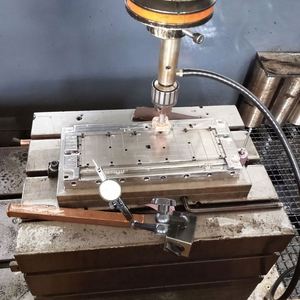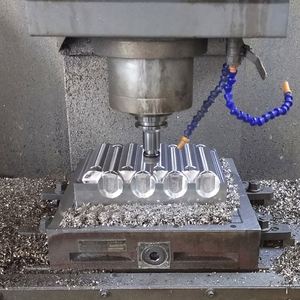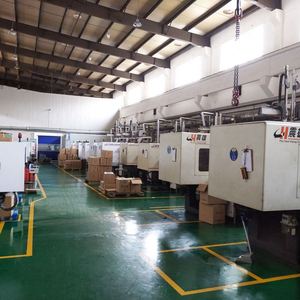
All categories
Featured selections
Trade Assurance
Buyer Central
Help Center
Get the app
Become a supplier

(209246 products available)




















Plastic production machines are specialized industrial equipment used to transform raw plastic materials into finished products or components. The types of plastic production machines are typically categorized based on the manufacturing process and the type of end products they create. Here are some key types of plastic production machines:
Plastic blow molding machine:
A plastic-making device for creating hollow items by distorting plastic. A hole is drilled into the warmed plastic preform, which is then mounted on a machine or blow mold. Following that, air is blasted through the preform to expand it and shape it into the mold's shape. Containers, bottles, and tanks are just a few examples of hollow items made with plastic blow molding devices.
Plastic injection making machine:
Plastic injection molding machines for sale work by heating and melting plasticized raw materials (usually in the form of pellets) and then injecting the molten plastic into a closed mold cavity under high pressure. The molten plastic cools and solidifies, taking on the shape of the mold. Once cooled, the mold is opened, and the finished plastic part is ejected. Injection molding machines are suitable for producing plastic items like toys, automotive parts, and household goods.
Plastic extrusion machine:
The process of using heat and pressure to produce plastic linear products is referred to as plastic extrusion. Extrusion involves thermal expansion and phase changes, during which the resin is melted into a huge volume and contoured to tiny, complex volumes. Products made with plastic extrusion machines include tubing, sheets, profiles, and films.
Rotational molding machines:
Rotational molding machines (also known as rotomolding machines) create hollow plastic things without seams using the rotational molding technique. The primary components of these machines are ovens and cooling chambers. A powder of plastic resin is placed in a single mold (which can be for multiple pieces in an assembly) that is then heated and rotated about two axes until the plastic coats the mold evenly and takes its shape. They create products such as storage tanks, boxes, and automotive components.
Both quality and performance are important aspects of a plastic manufacturing machines, and they are closely linked to the maintenance routine. The following specifications should usually be part of the maintenance routine.
Plastic-making machines are used in various industries because they can create different types of plastic products.
Mass production:
Industries such as packaging, construction, automotive, consumer goods, and electronics require a plastic-making machine that can create a large volume of products in a short time, such as bottles, containers, and car parts.
Product customization:
With interchangeable molds, plastic-making machines can produce products with different shapes, sizes, and functions, such as toys, household appliances, and gardening tools.
Cost-efficient manufacturing:
Because they can create many products at once, plastic-making machines are great for manufacturing that keeps costs down while meeting product needs. Examples include packaging for food and beverages, which require high quantities.
Quality control:
Areas such as the medical, automotive, and aerospace industries need plastic products with certain precision and quality. These industries often use machines that ensure each product meets specific standards and has consistent quality. For example, in the medical industry, machines might be used to produce surgical instruments or implants that require a high level of precision.
Rapid prototyping and production:
Plastic-making machines can quickly create prototypes and test models for new products in electronics, automotive, and consumer goods, allowing for faster product development and time-to-market.
Sustainable manufacturing:
When the plastic-making machine is used with recycling or eco-friendly technology, it can produce green or recycled materials, such as biodegradable plastic products or products made from recycled plastic.
Overall, depending on the product, type, and industry, people use different kinds of plastic-making machines. Here are some common ones:
Before investing in a plastic-making machine for sale, it is important to understand the requirements. Here are some of the parameters to consider when buying a plastic-manufacturing machine:
Business Model
The machine will vary depending on the business model. A distribution model will likely need a small-scale machine to produce various products. In contrast, those running a manufacturing plant for sale will need an industrial-scale machine for plastic products.
Production Capacity
It is important for wholesalers and retailers to match production capacity to demands. Furling factories will need a machine to make plastic products with higher capacities. Choosing a machine with flexible capacity can adjust output to meet changing demands.
Product Range
Determine the variety of plastic products to be produced before buying the plastic-making machine. Some machines are highly specialized, while others are more versatile. Choose a machine that can make the desired plastic products. In some cases, multiple machines may be needed to produce different types of plastic products.
Machine Efficiency
Typically, more efficient machines consume less energy, reduce waste, and require lower maintenance and operational costs. Check out the efficiency ratings of different plastic-making machines and pick out the most efficient.
Floor Space
Storage and display space is a big consideration for retail and wholesale buyers. Think of display space when buying a new product to sell. Make sure there is enough floor space to accommodate the new plastic-making machine.
Initial Investment
Funds are a restriction on the number of plastic-making machines that can be considered. Carefully calculate the total cost of ownership. This includes the purchase price and maintenance, energy requirements, production capacity, and resale value.
Availability of Parts
The location of dealers who sell spare parts is also important. It would be better to go with a machine that has local access to spare parts, technicians, and trained staff.
Environmental Impact
The choice of plastic-making machine can affect the environment. When choosing, think of recycling capabilities, carbon footprints, and all environmental impacts.
Q1: What are the most common types of plastic-making machines used for packaging?
A1: Blow molding, injection, and extrusion plastic-making machines are commonly used to produce packaging materials like containers, bottles, and protective packaging.
Q2: What kind of materials do plastic-making machines use?
A2: Plastic-making machines can process various materials, including thermoplastics such as polypropylene (PP), polystyrene (PS), polyethylene (PE), and polyethylene terephthalate (PET). Some machines can work with biodegradable plastics like PLA and PHA. Multifunctional plastic making machines can also handle plastic waste.
Q3: How much energy does a plastic-making machine use?
A3: The energy consumption of a plastic-making machine varies depending on its type, size, and the plastic making machine manufacturers. An injection machine uses between 30-150 kWh per ton of processed material. An extrusion machine uses between 30-90 kWh per ton. An average small recycling machine uses about 20,000 kWh in one year.
Q4: How does a plastic-making machine handle color additives?
A4: Colorants and additives are usually mixed with the raw plastic material before feeding it into the machine. Some machines also have a master batch addition system that allows operators to add color during production. Using color additives helps create products with vibrant colors and enhance UV resistance.